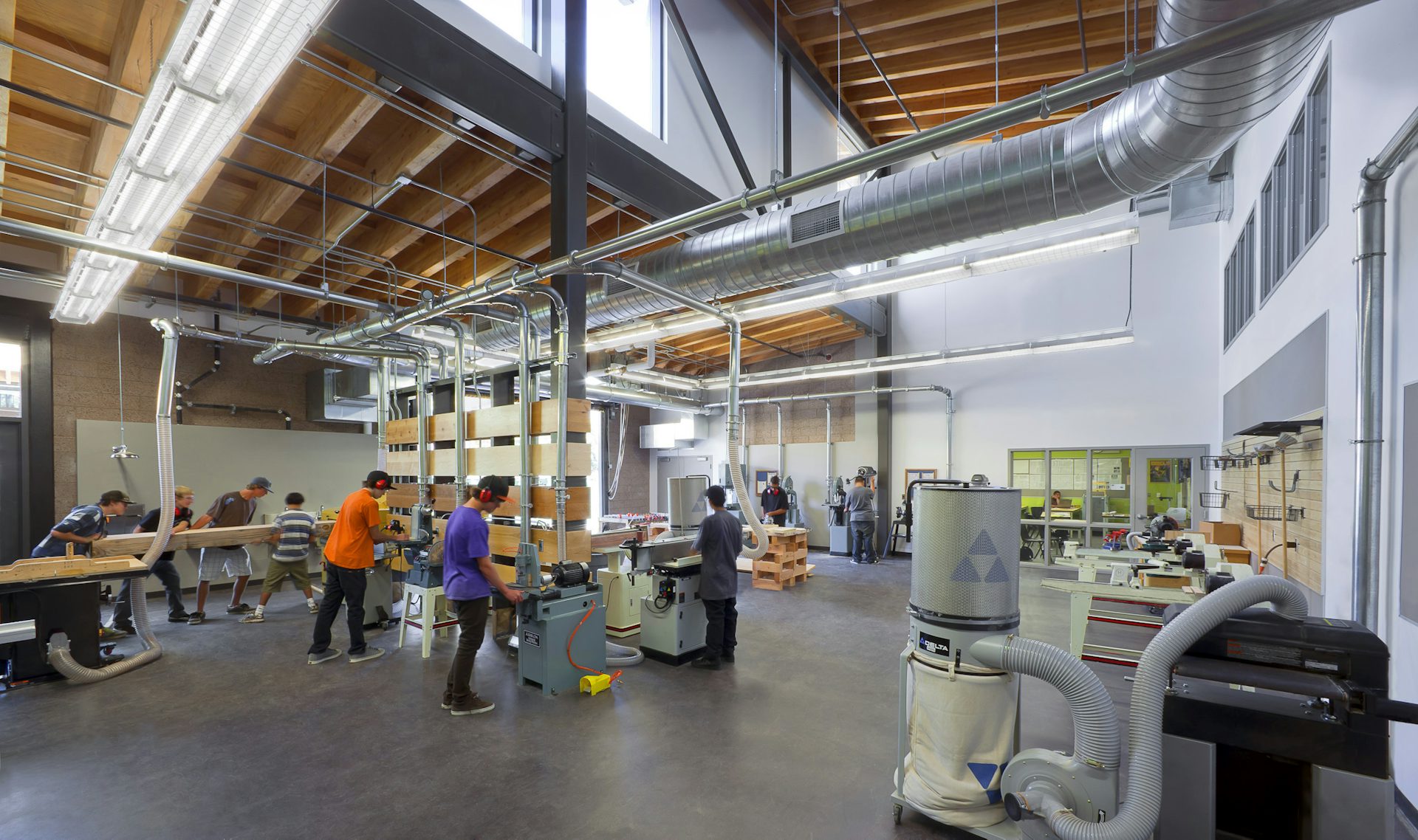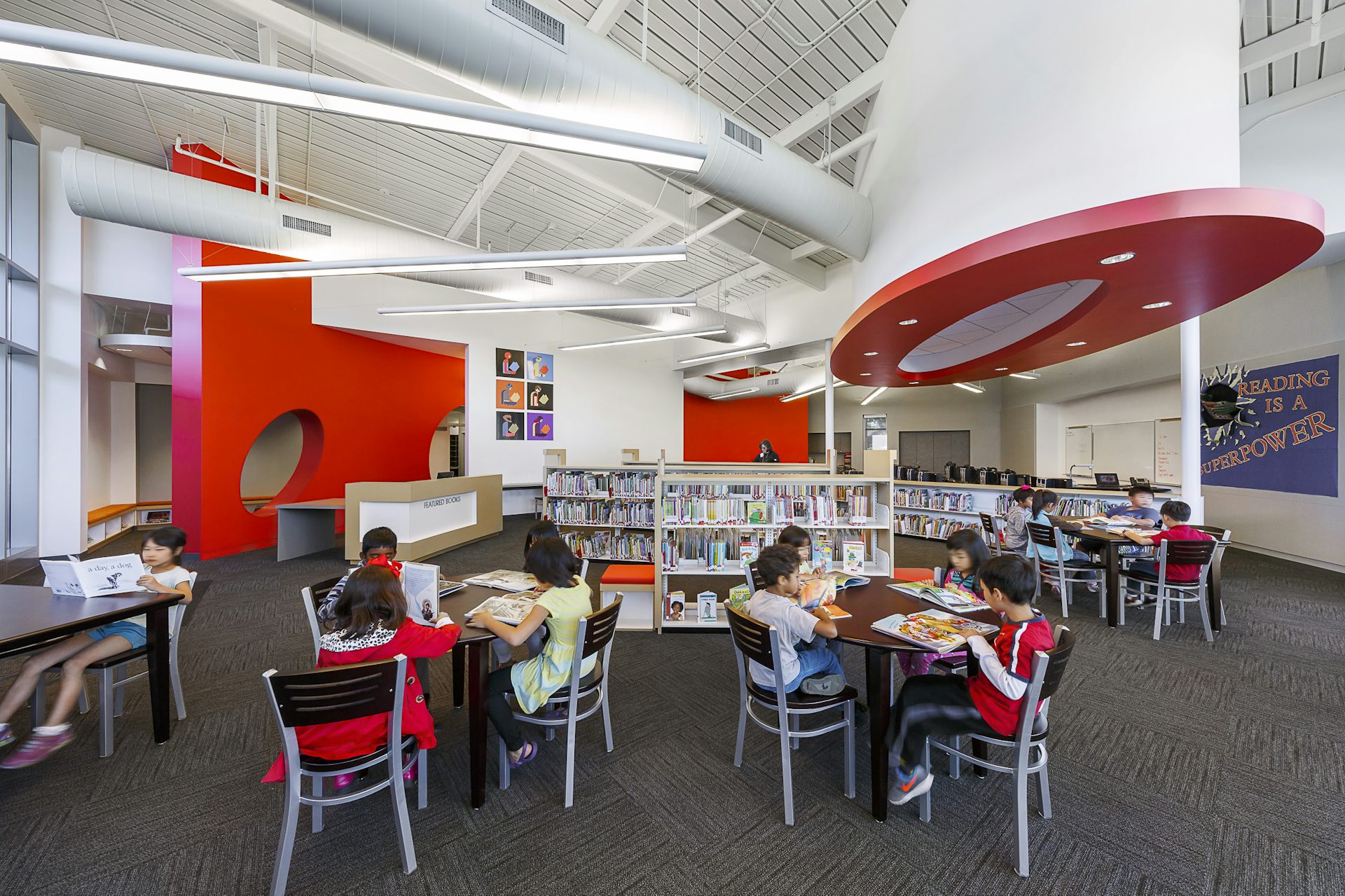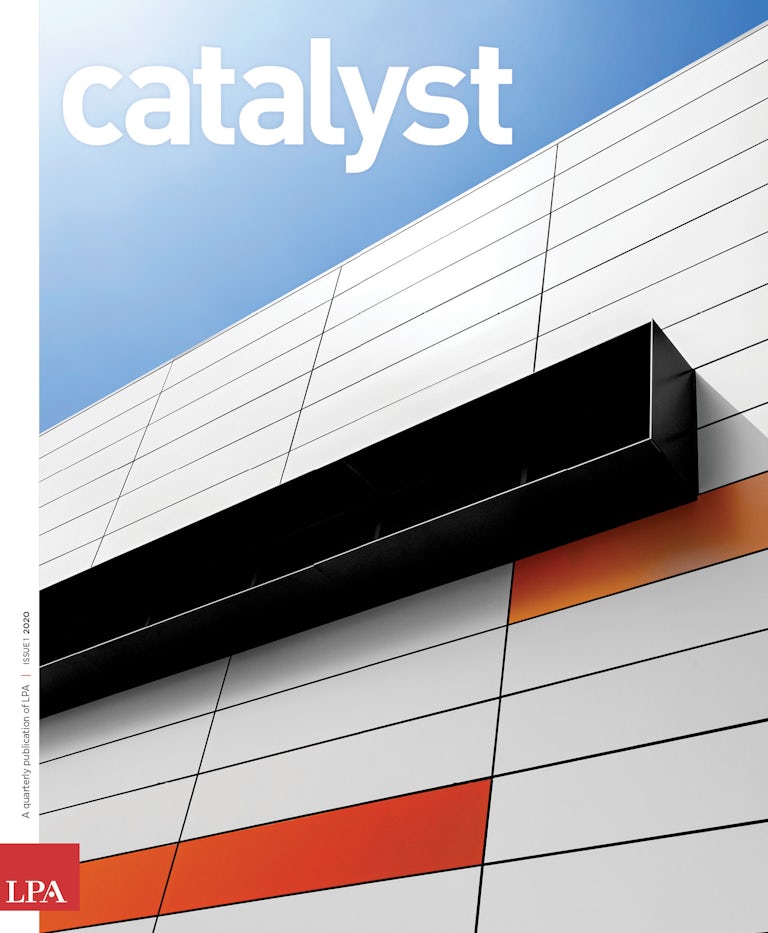Around the country, educators are rethinking the impact of school design on learners, looking for new ways to create environments that can support and inspire all aspects of their growth. More than ever, researchers agree that a well-designed campus can play a key role in developing happier, healthier students who perform better in the classroom and life.
In recent months, LPA designers and researchers have been exploring the changing landscape of K-12, discovering new ways to develop spaces that address the social and emotional well-being of students, as well as shifting pedagogical goals. In design charrettes, client meetings and post-occupancy research, the conversations have focused on the opportunity to reimagine existing campuses with spaces that meet the larger educational and community objectives.
“Rather than jumping into what is seen as the new trend, we want to step back and reflect on what it is students need and what we can do to support them,” says LPA Director of K-12 Jim Kisel.
Through the discussions, key themes emerged about methods to revitalize campuses and bring older facilities into alignment with modern educational delivery. Analysis of several recent campus renovation projects provided strong examples of how an inclusive design process and a focus on the needs of students led to flexible, innovative environments that spur collaboration, activate outdoor spaces and promote hands-on learning. In the examination, core concepts were raised repeatedly, elements considered essential to developing environments that address the cultural, social and emotional issues affecting students, while creating long-term value for districts.
“The role of students changes over time,” says education researcher and strategist Julie Zoellin Cramer, founder of Wayfind Education and a consultant with LPA. “What doesn’t change are the needs of the youth and who they are and their relationship to self and society.”
Breathing New Life Into Older Campuses
A research-driven approach to design unleashes new ideas to reimagine existing facilities as innovative learning spaces that work better for teachers and students.

Starting with the Student
The design process begins with an understanding of community and the learner profile. While common for new campuses, it is a step that is often overlooked for existing schools. The discovery process typically involves the community and parents, as well as teachers and students, to explore the graduate profile, student competencies, characteristics and desired student outcomes.
“In the end, it is answering what you want students to know, be able to do, and what you want them to value as they develop during their time within the learning environment,” Cramer says.
The learner-driven approach sets the foundation for the discussion, moving the design beyond templates and standard concepts to explore the specific demographics, requirements and goals of each campus. The characteristics of the spaces, the functional requirements and the opportunities in the adjacent spaces can all be evaluated in the context of the pedagogical vision.
“We’re talking about how physical space can engage a student’s sense of belonging to the academic environment, but also as a place to restore and reflect, a place to learn social engagement skills in a curated way,” Cramer says.

A Comprehensive Site Analysis
In the initial phases, it is essential to evaluate every space on campus to understand its adaptability and role in the long-term goals. The analysis should go beyond the cost of repairs to assess a wide range of elements, including operating efficiencies, security and the expense of adapting facilities to meet the program goals. The goal is to strategically focus on areas where meaningful change can be made, within the constraints of the budget and the site.
In some cases, it is surprising what can be saved. Working on three middle schools for the Westminster School District in California, we found that it was more cost effective to replace portable classrooms with new specialized lab spaces, as opposed to simply replacing portables with the same type of classroom space. The old, outdated labs were then renovated into state-of-the-art learning studios with strong connections to the outdoors.
In other cases, thorough analysis and estimate scenarios found that replacement was the more economical option. In the planning process for Casis Elementary School in Austin, Texas, LPA and partner Joeris General Contractors created five planning schemes which illustrated that the cost of a partial renovation was more expensive than new construction due to the expense of structural mitigation.
On several recent projects, LPA’s planning process included a detailed phasing scheme to keep classes operational throughout the construction process, reducing expenses and minimizing the effect on student experience.

PREPARING STUDENTS FOR THE REAL WORLD

Rethinking Space
One size doesn’t fit all. Each campus has its own individual characteristics, which lead to spaces based upon the values and priorities of each client.
“Rather than planning the classrooms as individual cells, we’re encouraging districts to think about the space with flexibility and variety—to really break outside of the box which may exist today,” Kisel says.
Existing spaces can be reconfigured and reimagined, even finger-style layouts. Space can be broken up into smaller areas and “learning neighborhoods” with shared collaborative zones. Different labs of varying sizes can be carved out of existing spaces, providing unique opportunities for art and maker spaces, STEM labs and specific hands-on opportunities to support specialized programs, including career and technical education. Special attention should be paid to opportunities for personalization, student ownership and small-group learning.
For Sheffield Elementary School in Carrollton-Farmers Branch ISD, after working through a series of visioning exercises and future-thinking assessments, the K-5 grade levels were arranged into cohorts, with a centralized collaborative space. “Instead of six of the same spaces, we’re looking at the different amenities within those rooms, to better align with the educational goals the district has and encourage collaboration,” says LPA Design Director Kate Mraw. Respite areas, intimate work areas and outdoor learning zones can be found in the spaces in between, enhancing student experience. Storage areas are masked with sliding writable walls, turning a dead zone into a potential teaching space. Library resources are distributed within collaborative areas, encouraging a love of reading and bringing resources, information and knowledge closer to the learning neighborhoods. As one teacher said, “Going to the library shouldn’t be a field trip.”

Break Down the Walls
Opening up spaces is not only about transparency. It’s also about developing adjacent uses and encouraging team teaching and collaboration, research shows. The design conversation is often about creating lines of sight and developing protocols for students to maximize the use of adjacent spaces as teaching spaces, especially outdoor areas.
“We’re talking more about how you break down that fourth wall to allow use of the outdoors in a more meaningful way,” says LPA Project Designer Lindsay Hayward. “How are you giving teachers and students more ownership of space so that it feels like it’s theirs to learn and teach in?”
On the Oliphant Elementary School campus in Indio, California, sliding glass walls have helped create an environment of sharing and collaboration, teachers say. Students can work in the built-in seating in the expanded circulation areas, while remaining visible from the main classroom. The glass walls also can be used as writable surfaces. Instead of a distraction, the glass has created new choices for teachers and students.
“We use the inclusion model and the learning commons can become an extension of the classroom,” says Oliphant third-grade teacher Lisa Nelson. “Looking outside you’re only seeing more learning, so it’s not a distraction.”

New Ways to Collaborate
Research illustrates that not all collaborative spaces are created equal. Spaces can be designed to support specific activities and different types of collaboration to make sure they are embraced and used by teachers and students.
LPAred, LPA’s research team, recently partnered with five LPA-designed elementary and high schools to study the effectiveness of a variety of collaborative spaces. In addition to validating the importance of collaboration in the learning and development process, two major themes emerged: Collaborative space fosters a range of learning and teaching activities and outcomes, and collaborative learning goes beyond teaching activities to support a variety of human needs and development.
Collaborative spaces that foster autonomy, choice and purpose can lead to increased motivation and engagement, the LPA study found. “To some extent this concept around collaboration is really about the way we gather and belong and learn,” Cramer says. “It’s not just about student-teacher relationship; it’s also about student-student relationships and teacher-teacher relationships.”
On existing campuses, those spaces can be created by something as simple as a learning nook or a well-placed furniture element. Existing concepts can be expanded to create new opportunities. On the Oak Grove High School campus for the East Side Union High School District, in San Jose, California, the old library was repurposed as a student union, a space that’s both interactive and informational, with spaces for small-group learning, project display and social engagement.

Agile Flexibility
Flexibility is essential to any campus design, allowing educators to use spaces for an array of activities. Flexibility is a way to future-proof learning environments, ensuring they will be relevant and effective for decades as pedagogies and the needs of students evolve.
But it’s important to recognize that there are different types of flexibility, which can impact the effectiveness of spaces. As part of the discussions with educators and students, it’s important to explore the spectrum of agile flexibility. The spectrum includes different ideas on how the spaces will be effective, such as “use flexibility,” focusing on the need to conduct a variety of activities within the space; “movement flexibility,” to allow easy movement in and around the space; and “tandem flexibility,” where the simultaneous use of adjacent spaces is critical.
“You want to get people’s true understanding of what they mean when they say we want it flexible,” Cramer says.

Learning Happens Everywhere
At the foundation of any renovation is the understanding that every space is a potential learning environment. Maximizing existing spaces and designing to create those opportunities can save money and create direct benefits for educators, while facilitating student choice.
The discussions often start with ideas to activate the outdoors, which is often underutilized on older campuses. “Outdoor spaces are now being considered core learning spaces,” Cramer says.
On an existing campus, designers look for opportunities in the spaces in between the core learning areas, including the connection between the indoor and outdoor environments.
A table in the corridor for a small group of students to gather, a niche in the wall with a bench and writable surfaces or roll-up doors connecting to the outdoors can activate spaces and encourage different types of learning and collaboration outside the classrooms.
The learning-happens-everywhere approach in a renovation is also supported by the addition of ubiquitous technology, including WiFi availability throughout the campus, adjustable lighting, display screens and writable walls to easily support activities for groups of different sizes.

Getting F.I.T.
The renovation process must recognize the shifting focus of teaching on each individual campus, LPA designers agree. One model is not always appropriate for every campus.
For Sheffield, LPA’s visioning engagement found that the educators anticipated curriculum after the renovation to shift from 50 percent teacher-directed learning to almost 80 percent student-led, requiring new ideas about how to address students’ choices and ownership of the environment. Any renovation should include the understanding that more specialized programs will develop in the years ahead.
For designers, it comes down to a focus on F.I.T.: Future-ready, Inspiring and Transformational. The concept provides a key method to evaluate how the design can exceed the fundamental goals of the school and district. Getting the most out of spaces requires a long-term approach to exploring new ways to expand learning opportunities and prepare students for the real world.
“Ultimately, so much of it comes down to student choice,” Mraw says. “A holistic environment should support human experience, both academically and socially.”

Five keys to modernizing learning environments
The foundation of any campus renovation should include several essential elements to achieve better student outcomes and ensure the spaces are useful for decades.
1. Promote Personalization A student’s sense of ownership is vital in developing an engaged learner. Flexible spaces should allow customization for presentations, discussions and play. When students feel they control a space and they can display their progress, they engage in their own learning path.
2. Design for Healthier Students Research confirms that healthier and happier students perform better. Natural light, better air quality and thermal comfort can all play key roles in a learner’s development. Play is a method of learning.
3. Develop Diverse Spaces There are different degrees of flexibility. Spaces should come in different scales to support different modes of learning. Include transparency to strengthen academic and visual connections.
4. Embrace Agility Spaces should be easily reconfigured to support different educational approaches. That means technology-rich spaces with varied furniture and mobile equipment. Agility is the best way to future proof a renovation.
5. Put the Outdoors to Work A connection to the outdoors and better views is a start. The outdoors should be activated as a learning tool that supports the campus’ academic goals.
CASE STUDY: BIG PLANS
Los Angeles Unified School District’s Alix Walsh O’Brien is bringing aspirational design, memorable spaces and a focus on the community to the renovation of schools in the country’s second largest district. In an exchange with Catalyst, she discusses the challenges and goals of the district’s massive renovation programs.















